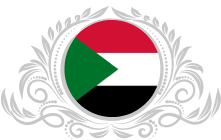
ANTIQUITIES AND TOURISM
The early history of human life in Sudan dates back to about 25,000 years, as evidenced by the discovery of what is known as the relics of Singa man.
There are four main sites and some other small ones whose history dates from 750 BC to 500 AD. Temples and pyramids, restored and kept in good shape, stand witness to those great civilizations that once prospered in the Sudan and influenced large parts of Africa.
Visits to the relics of the Merowe Kingdom usually take two days and one night for the visitor to become thoroughly acquainted with the many sites and relics. Further north of Merowe is Barkal, the Metropolis of the Napatan Kingdom, which lies some 400 kilometers north of Khartoum. Visitors will cross the Bayouda desert, a southern part of the western desert. It has a typical desert atmosphere, scattered with dunes, thorny acacia trees, and thick bushes.
Upon arrival at the massive Barkal Mount, the sacred and sanctimonious abode of the ancient Napatan kings, visitors will find a well-equipped camp ready to accommodate their every need. Centers are fully equipped, and guides are well acquainted with the traces and sites of the greatest civilization ever to be found in Africa.
The region abounds with pyramids, royal burial grounds, temples, and the lush greenery of palm date orchards along the Nile.
A tour may take more than a week after crossing the Western Nuba desert for a distance of 150 km, which takes from five to six hours to drive due to the sandy roads. Reaching the Nile after the blazing and scorching desert is a blessing. The ancient town of Kerma comprises one of the oldest and most unique civilizations in Sudan and Africa (2800 BC). Western archeological expeditions have repeatedly discovered evidence of the uniqueness and wonders of the Kerma civilization. The amphora found in significant quantities is characterized by fine quality and artistic nuances unparalleled in the ancient world.
Further north are the archaeological relics: the temples of Soleb and Sadenga, not far from the Nile.
In the adjacent Western desert, part of the Great Sahara, tours for desert lovers could readily be organized amid dunes and sparse oases where gazelles and rabbits are found. The tourists may define the length of such tours.
It is worth mentioning that most of the archaeological sites are located along the ancient caravan routes. At that time, Sudan served as a crossroads for African, Hellenic, Egyptian, and Mediterranean civilizations. Hence, several vital Sudanese towns sprang up to accommodate the movements and busy activity of transit caravans.
Most notable among such towns are Shendi, Suakin, Berber, Kassala, Dongola, Melit and Omdurman. These can be visited through tour programs. Kassala in eastern Sudan is an example of an urban center for the famous Beja tribes and the Rashaida people of the Arab peninsula. The town is known for its old traditional markets, artifacts, industries, and silverware.
Suakin’s old port, on the other hand, dates back to the times of Prophet Suleiman.
In western Sudan, along the borders with Libya, is the town of Melit, which stands as the starting point of the 40-day road. This famous historical route joins West Africa with the Middle East via Sudan. Although the road has lost its aura and continental importance today, it is still used by some tribes to herd camels to the markets of Egypt. Moreover, Melit town is regarded as a large camel market not only for Sudan alone but for neighboring African countries.


